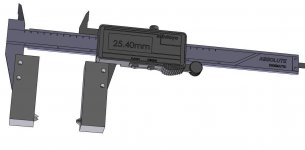Thread Pitch measuring
Yes the 0-25mm thread pitch micrometer came with 5 different size anvils and cones for measuring thread pitches as course as maybe 8tpi. I just made the caliper adapters to use the 3.49mm shank anvil and cones that came with a $60 pitch micrometer.
.....yes I have found squeezing and wiggle near anvil and cone end of the caliper jaws helps seat or lock them / align into thread better.
......yes I agree thread form is important. The major diameter is smaller than nominal size. (1/2-13 maybe .490-.495 +/-). Often a tight screw loosens as sharp vee peaks get worn down. Sometimes during cutting metal is pushes / formed and major diameter increases so I also keep measuring major diameter when close to pitch diameter. I have a kids toy digital usb microscope $65 that I have used a few times as a poor mans optical comparator.
........ the pitchmaster caliper attachment set is expensive. The caliper adapters I made out of aluminum in less than 2 hrs cost me nothing but the time to make. I found when I thought a thread was close and I was only taking 0.001" depth cuts I was still 0.010+ oversize. Just the measuring and getting an ideal how much more I had to go helps save alot of time. Now I can take 0.005" depth cuts (if screw big enough to take it) and get close much faster.
.......Even with a CNC lathe often when it is done cutting a thread it is 0.005" off and the tool modifier / offset needs adjusting. I found using just a nut as a gage for cutting screw threads was too slow, too easy to overshoot and have a loose /undersize thread.
...... Also I guess I am too used to digital. Be able to go mm/inch or zero to a certain size them measure how much the size difference is saves a lot of math errors. I get nice feeling of accomplishment cutting a thread to a pitch diameter tolerance chart and getting it to fit ok, not too tight or loose. On a Leblond lathe cutting metric threads the thread chasing dial does not work. I have to keep leadscrew engaged slow / brake to a stop, backup the cutter for clearance and run in reverse, bring cutter forward ready for next cut. Try doing that an extra 20 times when you do not have too if you can measure.
....... I used a digital indicator and magnetic base to measure tool post movement. I found the cross slide and compound slides needed the gibs tightened as it was jumping 0.010", this was not the normal lead screw backlash but the slides being loose from wear over the years. It is amazing how much easier it is now using a digital pitch caliper and a digital indicator and magnetic base to cut threads.


